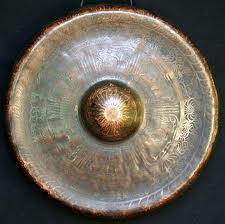A Brief History of the Gong
The gong was probably discovered by accident, perhaps as long as 6000 years ago and possibly in the following way; During the agricultural age when wheat had been discovered to be a good food source to feed tribes of people and was widely grown, the wheat was ground up and made into flour and very large ovens were carved out of huge rocks with a fire in the base to bake bread. It is believed that as these ovens were getting larger and hotter over time, minerals would run out of the rocks. At first tin formed a molten pool on the oven floor and later as the temperature rose, copper appeared. As these two metals combined together, bronze was created and when the oven cooled the circle of hardened metal in the bottom of the oven was the creation of the gong and this could have been the start of the Bronze Age.
In ancient times and today, the gong is used to start sumo wrestling contests.
Some gongs are loud enough to be heard from many miles away, and were used to signal workers in from the fields. In Asian cultures, the gong is an important part of celebrations, births, weddings and funeral ceremonies.
In the Buddhist culture, the gong is used today, as it was in the past, to start the beginning of meditation practice and to call group members to gather together.
Today, gongs are used in complementary therapy along with other instruments to entrain people to a theta brain wave state to
promote healing.

For more detail about the gong click HERE
